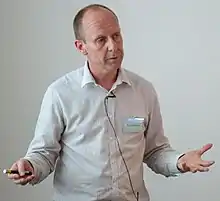Felix Armin Randow | |
|---|---|
 | |
| Nationality | German |
| Education | Goetheschule in Pritzwalk |
| Alma mater | Humbold-University in Berlin |
| Website | https://www2.mrc-lmb.cam.ac.uk/group-leaders/n-to-s/felix-randow/ |
Felix Armin Randow is a German molecular immunologist and tenured group leader at the MRC Laboratory of Molecular Biology in Cambridge. Guided by the importance of cell-autonomous immunity as the sole defender of unicellular organisms, Randow has made contributions to the understanding of host-pathogen interactions. He is an EMBO member, a Wellcome Trust investigator[1] and a Fellow of the Academy of Medical Sciences.[2]
Education
Randow grew up in Germany, where he was educated at Goetheschule in Pritzwalk and Humbold-University in Berlin. He obtained his PhD (Dr. rer. nat.) in 1997 under the guidance of Hans-Dieter Volk.
Career and Research
Between 1997 and 2002, Randow undertook postdoctoral research in the laboratory of Brian Seed at Harvard Medical School. In 2003, he became group leader at the MRC Laboratory of Molecular Biology in Cambridge. His work revealed novel principles of cell-autonomous immunity in human tissues, namely that human cells activate anti-bacterial autophagy when sensing endomembrane damage and that cells convert cytosol-invading bacteria into antibacterial signalling platforms by coating the bacterial surface with specific host proteins.
Randow's work has provided important insights into the mechanism of antibacterial autophagy. He discovered a new pathway of cell-autonomous defence relying on galectin-8 as the receptor for membrane damage caused by cytosol-invading bacteria,[3] NDP52 as the first anti-bacterial autophagy receptor,[4] and TBK1 as specifying the sites of anti-bacterial autophagy.[5] Because the galectin-8 pathway detects membrane damage rather than the invading pathogen per se, its importance likely reaches well beyond anti-bacterial defence, including protection against viruses and tauopathies.[6]
Randow's discovery of the E3 ubiquitin ligase LUBAC attaching M1-linked ubiquitin chains directly onto cytosol-invading bacteria, thereby activating NF-κB and autophagy, revealed another novel concept of cell-autonomous immunity, namely that cells transform bacteria into pro-inflammatory and anti-bacterial signalling platforms by coating their surface with ubiquitin.[7] His recent demonstration of guanylate-binding proteins (GBPs) encapsulating cytosolic bacteria, thereby preventing the infection of neighbouring cells, revealed that host cells generate a distinct variety of polyvalent protein coats on cytosolic bacteria as a means to antagonize bacteria and strengthen the host defence.[8]
Awards
References
- ↑ "Dr Felix Randow". Welcome Investigator Awards in Science. Wellcome Trust.
How pathogenic cytosol-dwelling bacteria escape from autophagy
- 1 2 "Dr Felix Randow". Academy of Medical Sciences.
- ↑ Thurston TL, Wandel MP, von Muhlinen N, Foeglein A, Randow F (January 2012). "Galectin 8 targets damaged vesicles for autophagy to defend cells against bacterial invasion". Nature. 482 (7385): 414–8. Bibcode:2012Natur.482..414T. doi:10.1038/nature10744. PMC 3343631. PMID 22246324.
- ↑ Thurston TL, Ryzhakov G, Bloor S, von Muhlinen N, Randow F (November 2009). "The TBK1 adaptor and autophagy receptor NDP52 restricts the proliferation of ubiquitin-coated bacteria". Nature Immunology. 10 (11): 1215–21. doi:10.1038/ni.1800. PMID 19820708. S2CID 17549881.
- ↑ Thurston TL, Boyle KB, Allen M, Ravenhill BJ, Karpiyevich M, Bloor S, Kaul A, Noad J, Foeglein A, Matthews SA, Komander D, Bycroft M, Randow F (August 2016). "Recruitment of TBK1 to cytosol-invading Salmonella induces WIPI2-dependent antibacterial autophagy". The EMBO Journal. 35 (16): 1779–92. doi:10.15252/embj.201694491. PMC 5010046. PMID 27370208.
- ↑ Falcon B, Noad J, McMahon H, Randow F, Goedert M (February 2018). "Galectin-8-mediated selective autophagy protects against seeded tau aggregation". The Journal of Biological Chemistry. 293 (7): 2438–2451. doi:10.1074/jbc.M117.809293. PMC 5818177. PMID 29282296.
- ↑ Noad J, von der Malsburg A, Pathe C, Michel MA, Komander D, Randow F (May 2017). "LUBAC-synthesized linear ubiquitin chains restrict cytosol-invading bacteria by activating autophagy and NF-κB". Nature Microbiology. 2 (7): 17063. doi:10.1038/nmicrobiol.2017.63. PMC 5576533. PMID 28481331.
- ↑ Wandel MP, Pathe C, Werner EI, Ellison CJ, Boyle KB, von der Malsburg A, Rohde J, Randow F (October 2017). "GBPs Inhibit Motility of Shigella flexneri but Are Targeted for Degradation by the Bacterial Ubiquitin Ligase IpaH9.8". Cell Host & Microbe. 22 (4): 507–518.e5. doi:10.1016/j.chom.2017.09.007. PMC 5644667. PMID 29024643.
- ↑ "Felix Randow". EMBO profile. European Molecular Biology Organization.